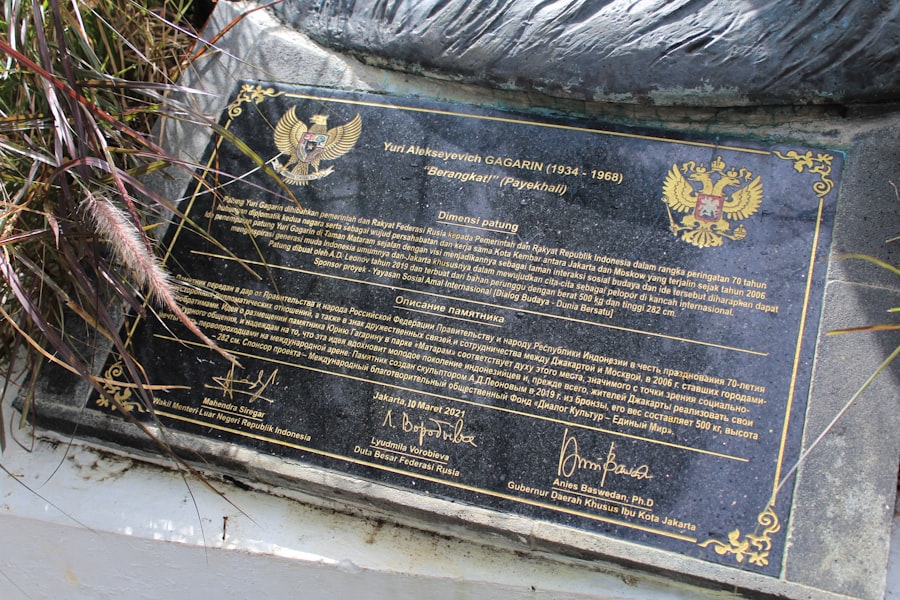Yuri Gagarin was born on March 9, 1934, in the small village of Klushino, located in the Smolensk region of Russia. His parents, Alexei Ivanovich Gagarin and Anna Timofeyevna Gagarina, were engaged in farming, which provided a modest but stable upbringing for their son. Growing up in a rural environment, Gagarin developed a fascination with aviation at an early age.
This interest was further fueled by the sight of aircraft flying overhead during World War II, which left a lasting impression on him. The war also had a profound impact on his childhood; the family faced hardships, including food shortages and the destruction of their village. These experiences instilled in Gagarin a sense of resilience and determination that would later define his character.
After the war, Gagarin pursued his education with vigor. He attended a technical school in Lyubertsy, where he excelled in his studies and developed a keen interest in engineering. His passion for flying led him to join a local flying club, where he took his first steps toward becoming a pilot.
In 1955, he enrolled in the Soviet Air Force School in Orenburg, where he underwent rigorous training. Gagarin’s natural aptitude for flying quickly became apparent; he was not only skilled but also demonstrated exceptional leadership qualities. His training included both theoretical knowledge and practical flying experience, which prepared him for the challenges he would face as an astronaut.
By 1957, he had graduated and earned his wings as a pilot, marking the beginning of a remarkable journey that would culminate in his historic flight into space.
Key Takeaways
- Gagarin was born in a small village and trained as a pilot in the Soviet Air Force before being selected for the space program.
- His historic flight on April 12, 1961, made him the first human to travel into space, orbiting the Earth once and becoming an international hero.
- After his space mission, Gagarin continued to work in the space program and became a prominent figure in the Soviet Union, traveling the world as a symbol of Soviet achievement.
- Gagarin’s legacy includes inspiring future generations of astronauts and space explorers, and his name is honored in numerous ways around the world.
- His space mission had a significant impact on the space race, boosting Soviet prestige and leading to increased competition with the United States in space exploration.
The Historic Flight
On April 12, 1961, Yuri Gagarin made history as the first human to journey into outer space aboard the Vostok 1 spacecraft. The mission was a monumental achievement for the Soviet space program and represented a significant milestone in human exploration. The launch took place from the Baikonur Cosmodrome in Kazakhstan, a site that would become synonymous with space exploration.
As Gagarin ascended into the atmosphere, he experienced the thrill of weightlessness and witnessed the breathtaking view of Earth from above—a sight that few had ever seen before. The flight lasted approximately 108 minutes and completed one orbit around the planet, during which Gagarin famously exclaimed, “Poyekhali!” or “Let’s go!” This phrase became emblematic of the spirit of exploration and adventure that characterized the space race. The technical aspects of the Vostok 1 mission were groundbreaking.
The spacecraft was equipped with a series of systems designed to ensure Gagarin’s safety and success during the flight. It featured an automated control system that allowed for a smooth ascent and re-entry, although Gagarin himself had to manually control the spacecraft during certain phases of the mission. The successful completion of this flight not only showcased Soviet engineering prowess but also demonstrated the potential for human space travel.
Upon re-entry, Gagarin ejected from the capsule at an altitude of about seven kilometers and parachuted safely to the ground, landing near the town of Engels. His safe return marked a triumphant moment for the Soviet Union and solidified his status as a national hero.
Life After the Space Mission

Following his historic flight, Yuri Gagarin became an international celebrity and a symbol of Soviet achievement in space exploration. He was celebrated not only in his home country but also around the world as a pioneer who had pushed the boundaries of human capability. Gagarin embarked on a global tour, visiting numerous countries where he was greeted with admiration and awe.
His charm and humility endeared him to people from various backgrounds, transcending political barriers during a time when tensions between East and West were high due to the Cold War. Despite his newfound fame, Gagarin remained grounded and committed to his roots. In addition to his public engagements, Gagarin continued to serve in the Soviet Air Force and pursued further training as an astronaut.
He was involved in various space-related projects and contributed to the development of future missions. However, he faced challenges as well; the intense scrutiny and pressure that came with his celebrity status took a toll on his personal life. Gagarin struggled to find a balance between his responsibilities as an ambassador for space exploration and his desire for a normal family life.
He married Valentina Ivanovna Gagarina in 1957, and they had two daughters together. Despite the demands of his career, Gagarin cherished his family life and sought solace in their company whenever possible.
Gagarin’s Legacy
| Aspect | Metrics |
|---|---|
| Space Exploration | First human in space |
| Impact | Inspiration for future astronauts |
| Legacy | Pioneering space exploration |
Yuri Gagarin’s legacy extends far beyond his historic flight; he is remembered as a symbol of human ingenuity and courage in the face of adversity. His achievement inspired generations of scientists, engineers, and aspiring astronauts around the globe. The significance of his mission cannot be overstated; it marked the beginning of human space exploration and opened new frontiers for scientific discovery.
Gagarin’s journey into space ignited interest in space travel among young people worldwide, leading many to pursue careers in science and technology. In Russia, Gagarin is celebrated as a national hero whose contributions to space exploration are commemorated annually on April 12th, known as Yuri’s Night or World Space Day. Statues and monuments have been erected in his honor, serving as reminders of his pioneering spirit.
Educational institutions have also been named after him, ensuring that future generations will learn about his remarkable achievements. Furthermore, Gagarin’s legacy is reflected in popular culture; films, books, and documentaries have been produced to tell his story and highlight the significance of his contributions to humanity’s quest for knowledge beyond our planet.
Commemorations and Honors
Yuri Gagarin’s contributions to space exploration have been recognized through numerous awards and honors both during his lifetime and posthumously. Shortly after his historic flight, he was awarded the title of Hero of the Soviet Union, the highest honor bestowed upon individuals for extraordinary feats in service to the nation. This recognition was accompanied by various medals and accolades from different countries, reflecting his status as an international icon of space exploration.
In addition to state honors, Gagarin has been commemorated through various initiatives aimed at preserving his legacy. Numerous educational programs have been established to promote interest in science and technology among young people, inspired by Gagarin’s achievements. Space agencies around the world have also paid tribute to him by naming missions and spacecraft after him.
For instance, NASA’s Space Shuttle program included missions named “Gagarin” to honor his pioneering spirit. Furthermore, international collaborations in space exploration often reference Gagarin’s contributions as a reminder of the shared human endeavor to explore beyond our planet.
Impact on the Space Race
Yuri Gagarin’s successful flight into space had profound implications for the ongoing Space Race between the United States and the Soviet Union during the Cold War era. His achievement not only showcased Soviet technological prowess but also served as a powerful propaganda tool for the Soviet government. The successful launch of Vostok 1 demonstrated that the USSR was at the forefront of space exploration, prompting a sense of urgency within American political circles to accelerate their own space program.
In response to Gagarin’s flight, NASA intensified its efforts to send an American astronaut into space. This led to significant advancements in technology and increased funding for space exploration initiatives in the United States. The Mercury program was expedited with John Glenn eventually becoming the first American to orbit Earth in 1962—an achievement directly influenced by Gagarin’s groundbreaking mission.
The competition between these two superpowers fueled rapid advancements in aerospace technology and laid the groundwork for future collaborative efforts in space exploration.
Gagarin’s Personal Characteristics
Yuri Gagarin’s personal characteristics played a crucial role in shaping both his success as an astronaut and his enduring legacy as a cultural icon. Known for his charisma and affable nature, Gagarin possessed an innate ability to connect with people from all walks of life. His humility stood out even amidst global fame; he often downplayed his achievements and emphasized teamwork over individual glory.
This quality endeared him to both colleagues and admirers alike. Moreover, Gagarin exhibited remarkable resilience throughout his life. From overcoming childhood hardships during World War II to navigating the pressures of fame after his historic flight, he demonstrated an unwavering commitment to pursuing his dreams despite obstacles.
His dedication to aviation and space exploration was evident not only in his professional endeavors but also in his personal life; he remained passionate about flying even after achieving monumental success as an astronaut.
Controversies and Conspiracy Theories
Despite Yuri Gagarin’s celebrated status as a pioneer of space exploration, various controversies and conspiracy theories have emerged surrounding aspects of his life and career. One notable controversy involves claims regarding the true nature of his flight into space; some skeptics have suggested that elements of Gagarin’s mission were exaggerated or fabricated by Soviet authorities for propaganda purposes. These claims often stem from broader discussions about state control over information during the Cold War era.
Additionally, there are conspiracy theories surrounding Gagarin’s untimely death on March 27, 1968, when he tragically perished in a plane crash during a routine training flight. Some theorists speculate that foul play may have been involved due to his status as a national hero or suggest that he may have been silenced due to knowledge about classified information related to space missions. However, official investigations concluded that pilot error contributed to the accident, leading many historians to dismiss these theories as unfounded speculation.
Gagarin’s life remains an enduring testament to human courage and curiosity about our universe despite these controversies surrounding him. His legacy continues to inspire future generations as we strive toward new frontiers in space exploration while grappling with complex narratives about history and truth.


